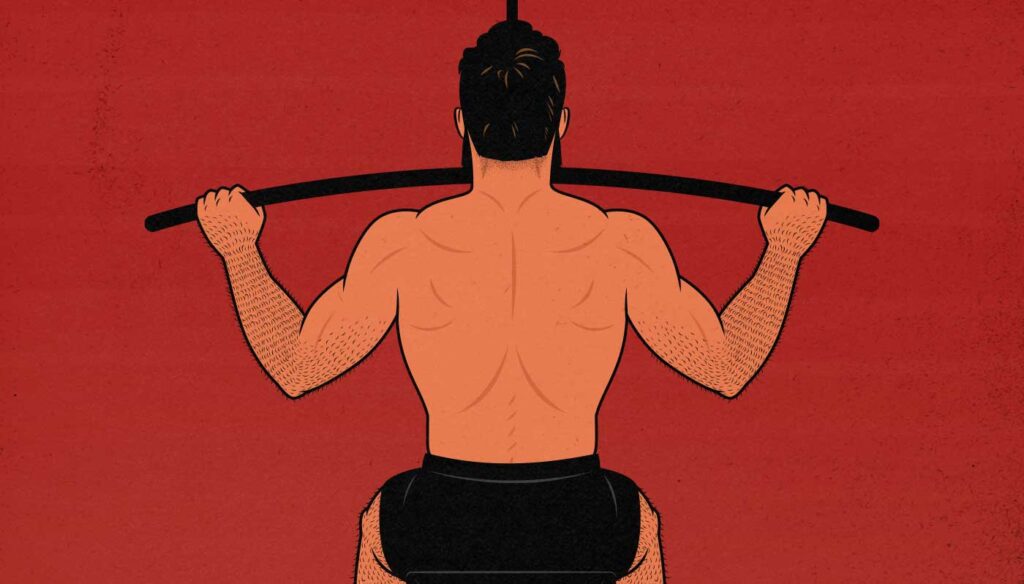
Lat Pulldown Alternatives: How to Train Your Lats With Free Weights
One of the most common questions we get is how to do lat pulldowns without a lat pulldown machine. People are training at home with either a barbell or dumbbells, and they aren’t sure how to replace the lat pulldown exercise with free weights. And, the truth is, there’s no perfect replacement for it. We need to replace it with a similar exercise, not an identical one.
The movement that best mimics the overhand lat pulldown is the pull-up, and that’s great for people who have a pull-up bar and are strong enough to do them, but even then, it can still create problems.
Lat pulldowns are often programmed in moderate rep ranges of 8–15 reps, but it takes quite a lot of upper-body strength to bust out that many pull-ups, especially if you’re already fatigued from other exercises. That’s a problem because lat pulldowns are often programmed after heavy sets of chin-ups and pull-ups.
So, what’s the best free-weight alternative to the lat pulldown?
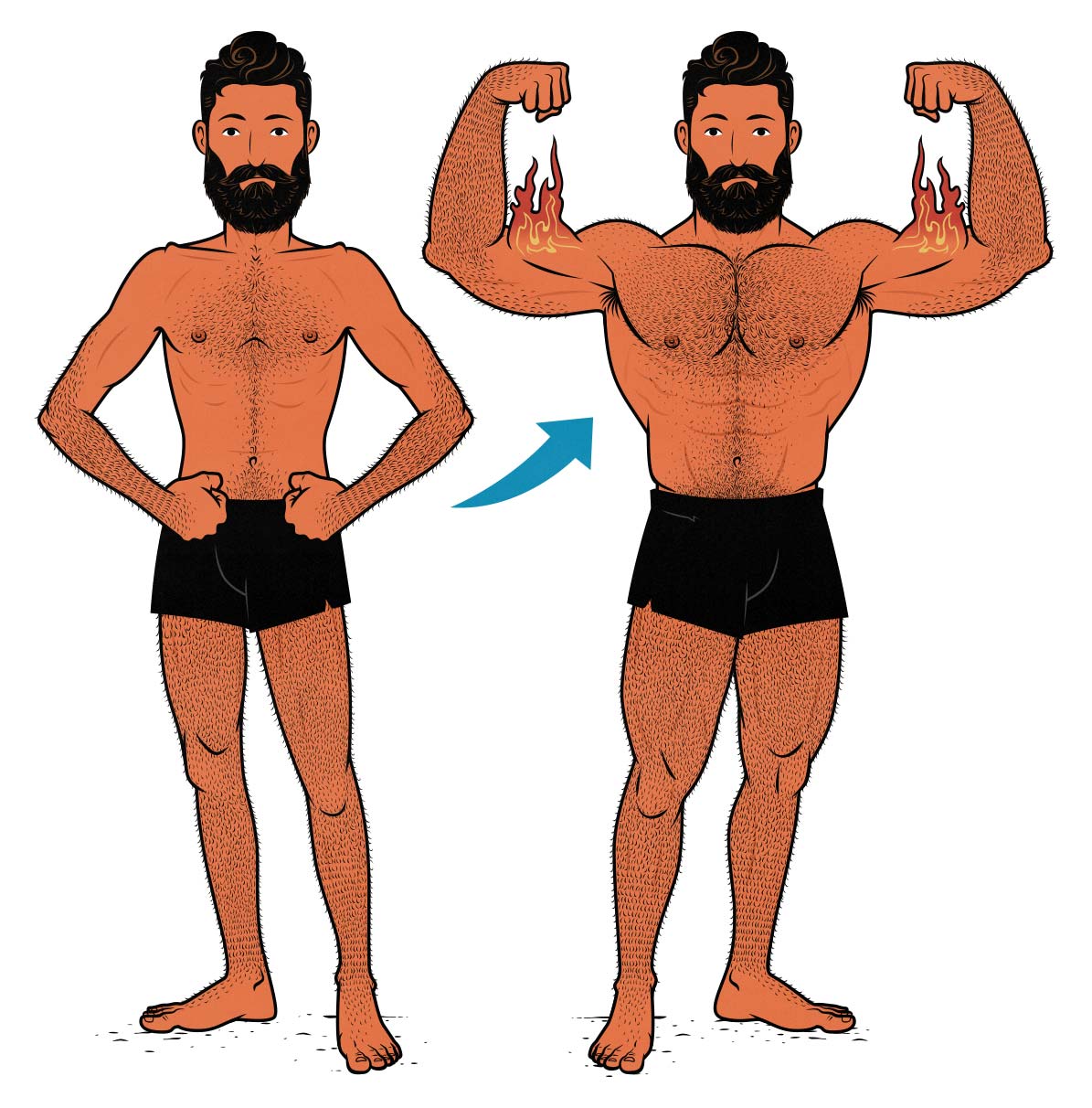
What Muscles Does the Lat Pulldown Work?
There are a couple of different ways of doing lat pulldowns. If you use an underhand, shoulder-width grip, it’s similar to a chin-up. It’s a bigger lift that works both your biceps and upper back. The more popular way of doing lat pulldowns is with a wider, overhand grip, though. More like the grip you’d use when doing pull-ups.
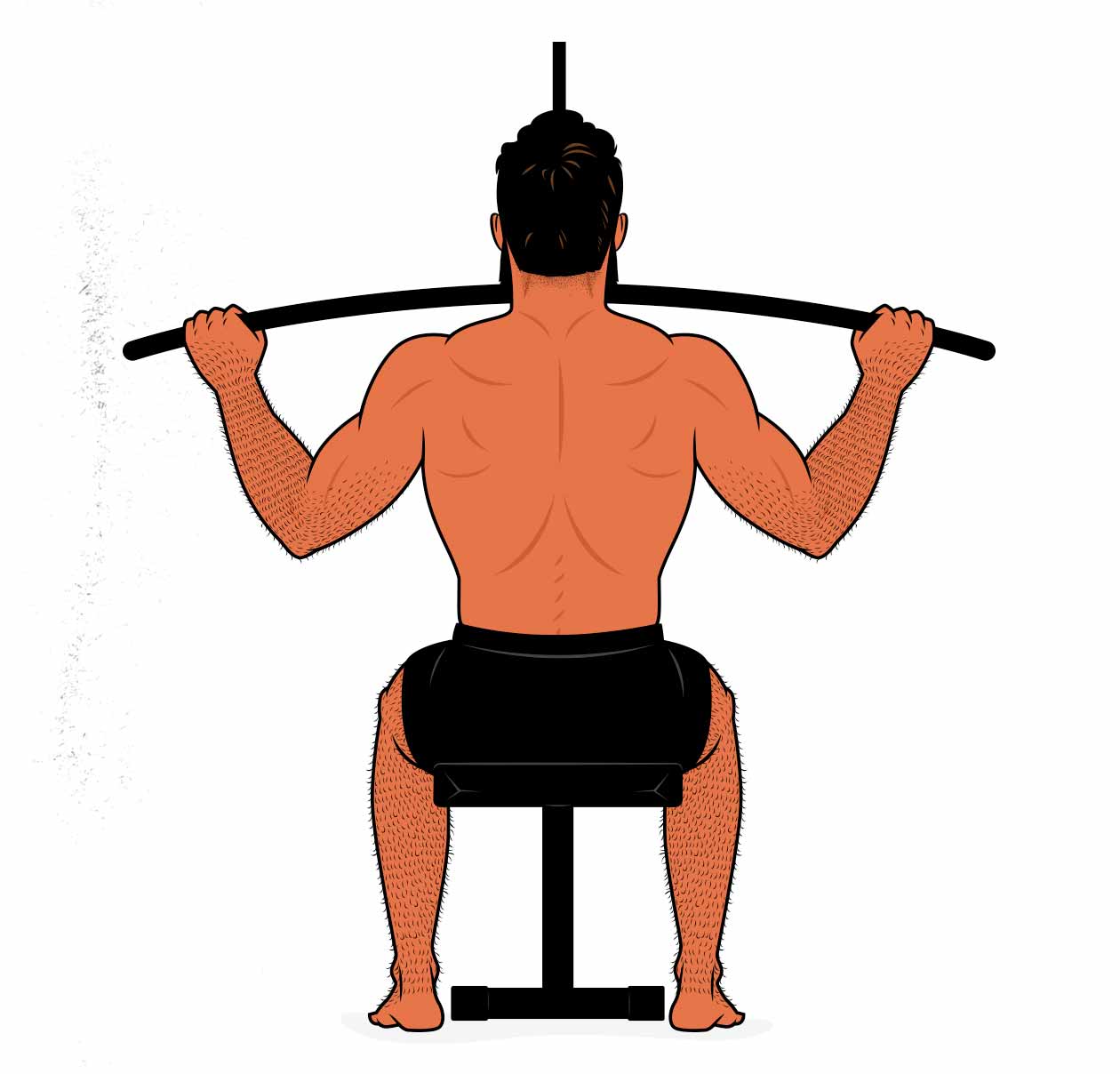
When you use an overhand grip, it prevents your biceps from fully engaging, and when you use a wider grip, it emphasizes your lats over your other upper-back muscles. It’s a lat lift, hence the name: the lat pulldown.
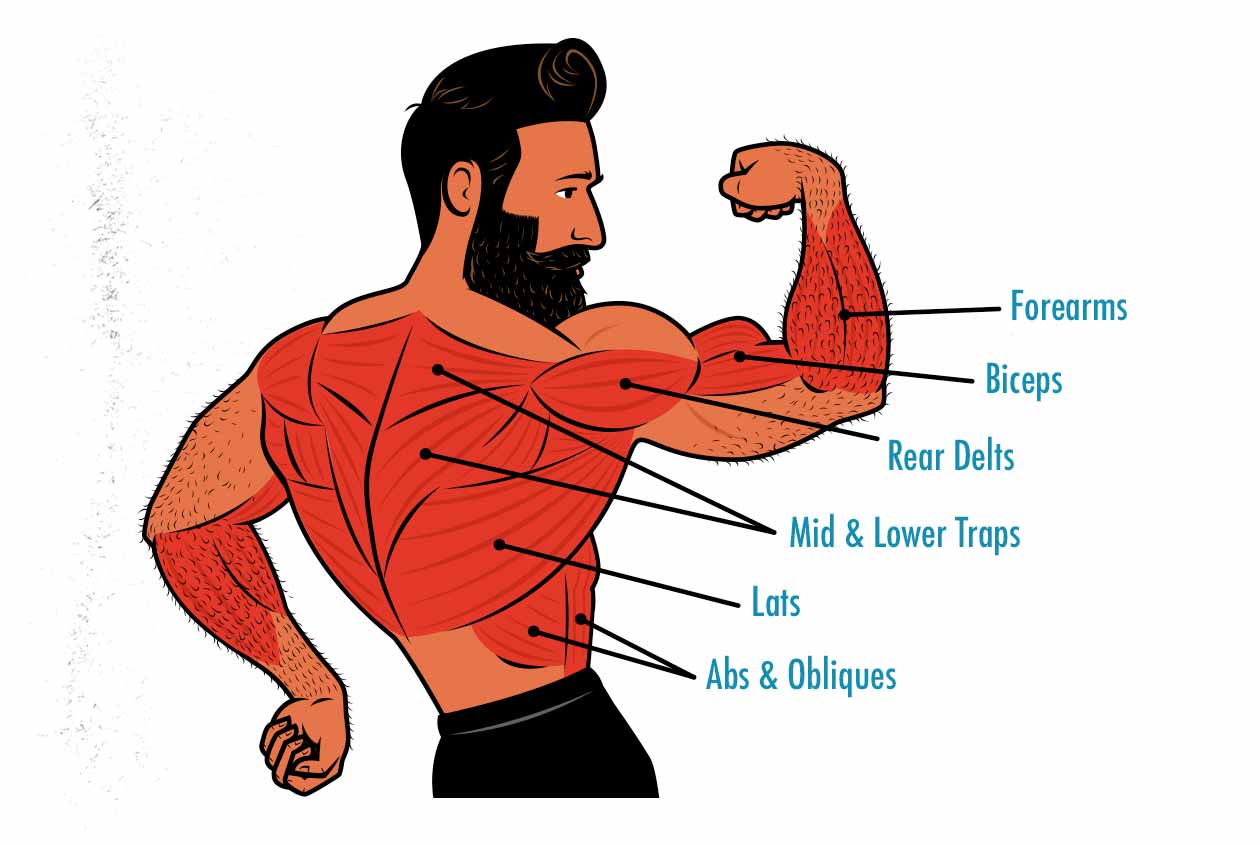
Even so, as much as the lat pulldown works our lats, it’s still a compound lift, and it still works a wide variety of other muscles, ranging from your rear delts to your abs to your forearms. It will even work the long head of your triceps a little bit, since they help to pull your elbows closer to your body.
What that lat pulldown is best at, though, is bulking up your lats. It starts with your lats in a deep stretch, works them through a full range of motion, and our strength limits our performance. The strength curve isn’t ideal since the lift is easiest where our lats are strongest (in a deep stretch), but it still works them hard through a full range of motion. This gives us a great lat exercise.
So, ideally, we’d find a substitute that works our arms and upper back, but the main thing we’re looking for is an exercise that works your lats hard through a large range of motion.
Lat Pulldown Alternative with a Barbell Home Gym
If you’ve got a barbell home gym, chances are you’ve got a squat rack with a chin-up bar. That gives you a near-perfect alternative to the lat pulldown. In fact, if anything, chin-ups and pull-ups are better than lat pulldowns for building muscle in our biceps and upper back.
The thing is, the minimum weight you can use is your body weight, so it can become hard to venture into higher rep ranges, especially if you’re still relatively new to lifting weights. Plus, lat pulldowns are often used as an assistance lift for the chin-up. Your workout sheet probably looks like this:
- Chin-ups: 4 sets of 6–8 reps to work the upper back and biceps.
- Lat pulldowns: 3 sets of 10–12 reps to give your lats some extra love.
So you can’t exactly replace the lat pulldown with chin-ups or pull-ups. You’ve already done those, you’re already tired, and the whole point is to add extra exercise variety and to use a higher rep range.
On the note of higher rep ranges, the research shows that it’s quite a bit easier to build muscle when doing sets of 6–20 reps, with the middle of that range often being the most convenient. That’s why you’ll often see lat pulldowns programmed for those 10–12 rep sets, and that’s why we need to find a substitute that lets you do enough reps.
Still, let’s start with the heavy hitters.
The Pull-Up
The pull-up is super similar to the lat pulldown. In fact, if you had to pick between the two, the pull-up is the better lift. It works the lats just as hard, we’re often slightly stronger at it, and it does a great job of engaging our abs.
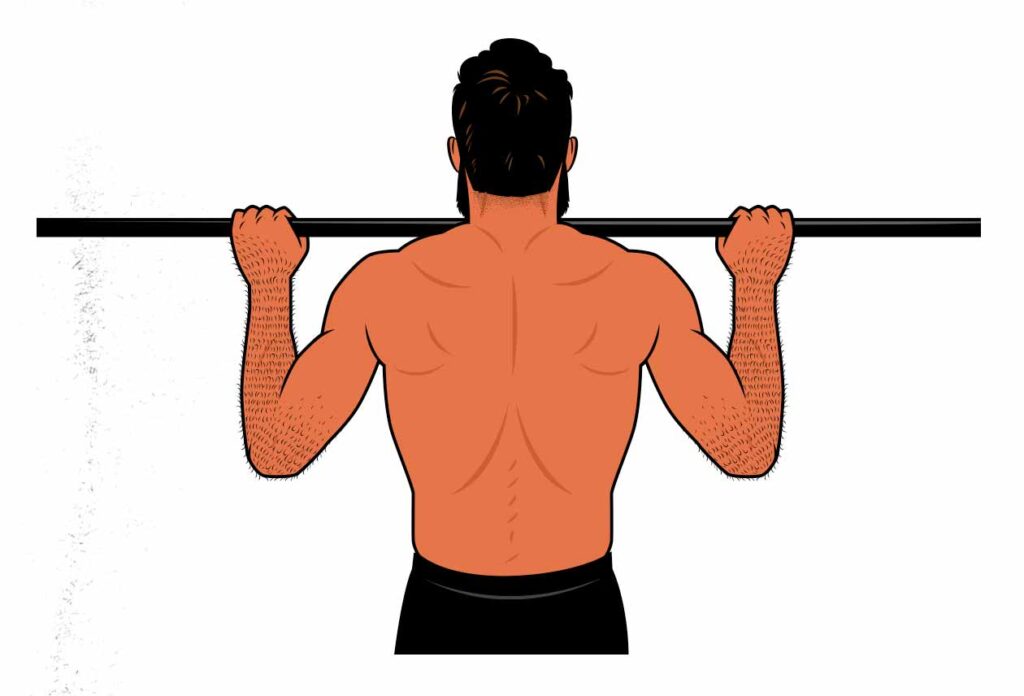
The only problem with the pull-up, as mentioned above, is that you need to be quite strong, and you’re probably already doing them anyway.
The Chin-Up
The chin-up is perhaps the very best upper-body pulling exercise. It challenges all of the muscles in our upper backs except for our spinal erectors. And since our spinal erectors are hit so hard by the deadlift and barbell row, it can be a great exercise for bringing up the rest of our upper-back muscles.

If you’re not strong enough to do moderate-rep sets of pull-ups, you might be strong enough to do moderate-rep sets of chin-ups. After all, when we’re doing chin-ups, we’ve got our biceps and other upper-back muscles firing in full force. If you can do 3–4 pull-ups, maybe you can squeeze out 6–8 chin-ups. Those couple extra reps bring your sets into the hypertrophy rep range, allowing you to stimulate a little bit more muscle growth per set.
But chin-ups still suffer from the same problem as pull-ups. You’re probably already doing them, and you probably want something a bit lighter.
The Barbell Pullover
Pullovers aren’t a perfect substitution for lat pulldowns. Pulldowns put more emphasis on your lats, whereas pullovers put more emphasis on your teres major. However, the teres major sits underneath your lats, so most people group the two muscles together. Thus, when someone has “big lats,” they have a combination of big lats and big teres majors.
The barbell pullover can be done with a straight barbell, but if you have one, a curl bar (aka EZ-Bar) might feel a bit more comfortable on your elbows. It’s done by lying flat on a bench and lowering your arms back behind your head, like so:
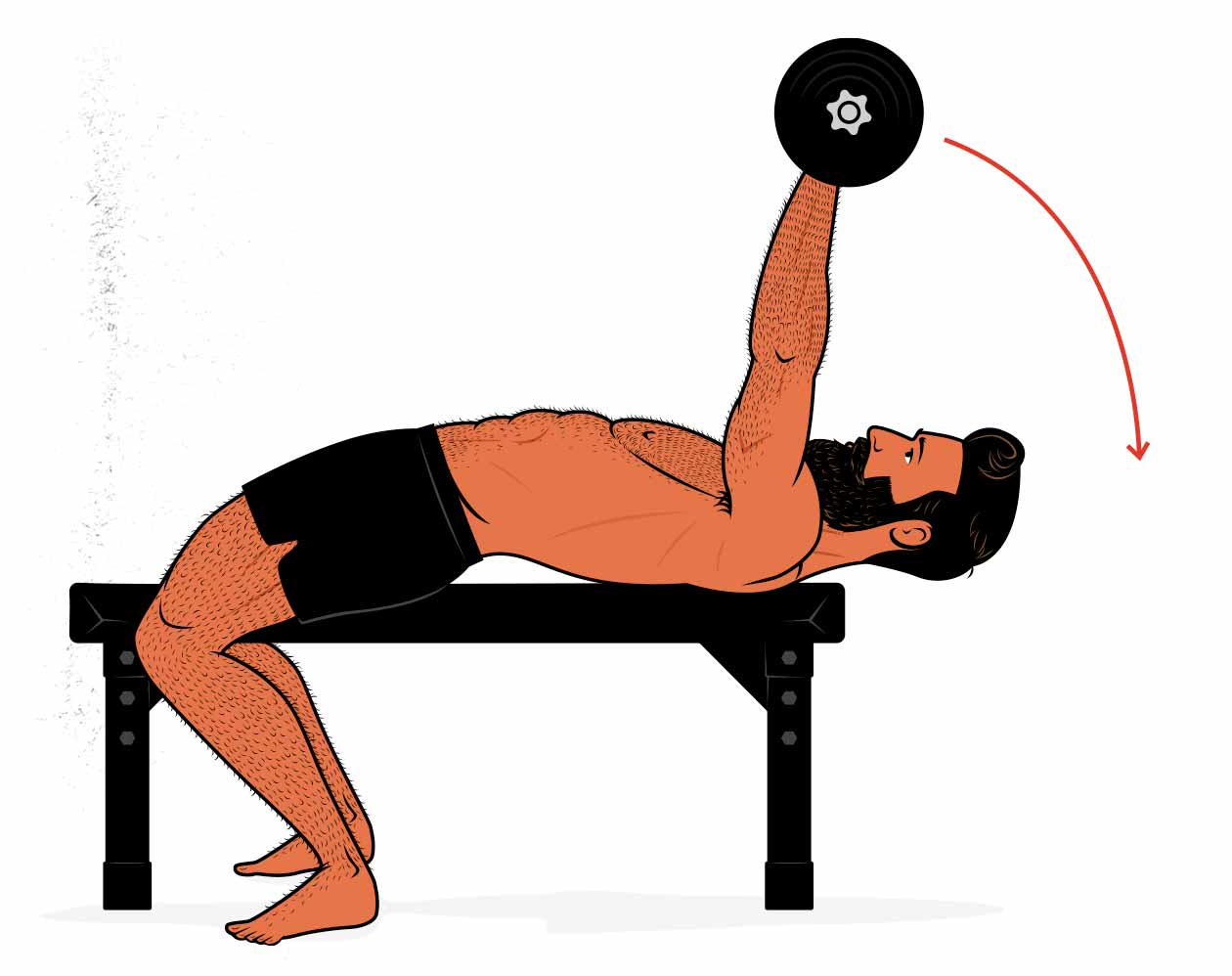
You can do it lying on the bench (as shown above) or lying crosswise against it with your butt in the air. You can rest your head on the bench or have it hanging off the end (as shown above). All of those variations are fine, and they all allow you to train your lats equally well, so just choose the one that feels best.
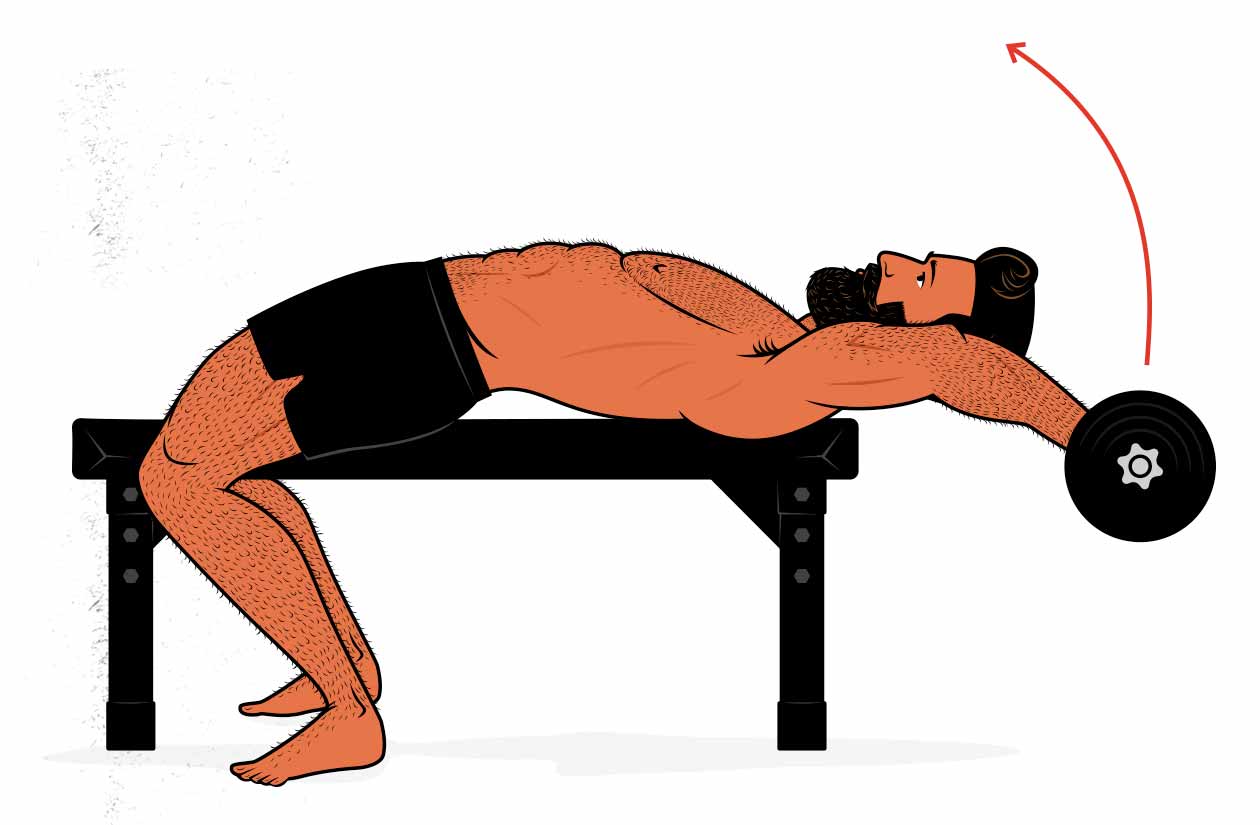
The idea is to bring the barbell down as far as your shoulder mobility allows, giving your upper back muscles a nice, deep stretch. You can let your elbows bend a bit, and that might make the lift a bit easier on your triceps, but it will work both your triceps and your upper back either way. Again, do what feels best.
The barbell pullover is arguably the best barbell replacement for the lat pulldown. Here’s why:
- You get a deep stretch on your teres major at the bottom of the lift, training them through the most important part of the range of motion—the deep part.
- The pullover has a fantastic strength curve. It’s hardest at the bottom of the range of motion, working your muscles where it matters most.
- You can use whatever load you want, lift in any rep range, and progressively overload it.
- It pairs well with pull-ups and chin-ups, making it a good secondary exercise.
Lat Pulldown Alternative with a Dumbbell Home Gym
If you’re training at home with just dumbbells, our approach is almost identical. Ideally, you’d have a chin-up bar that allows you to do chin-ups and pull-ups for your heavy sets, but you might not. You might need to use the dumbbell row as your main upper-back lift, and that’s fine.
Whatever you’re using as your main upper-back lift, you can use the dumbbell pullover as the replacement for the lat pulldown.
The Dumbbell Pullover
The dumbbell pullover can be done by cradling a dumbbell in your palms, and then once you grow too strong for that, by holding a dumbbell in each hand. It’s done by lying on a bench and lowering your arms back behind your head, like so:
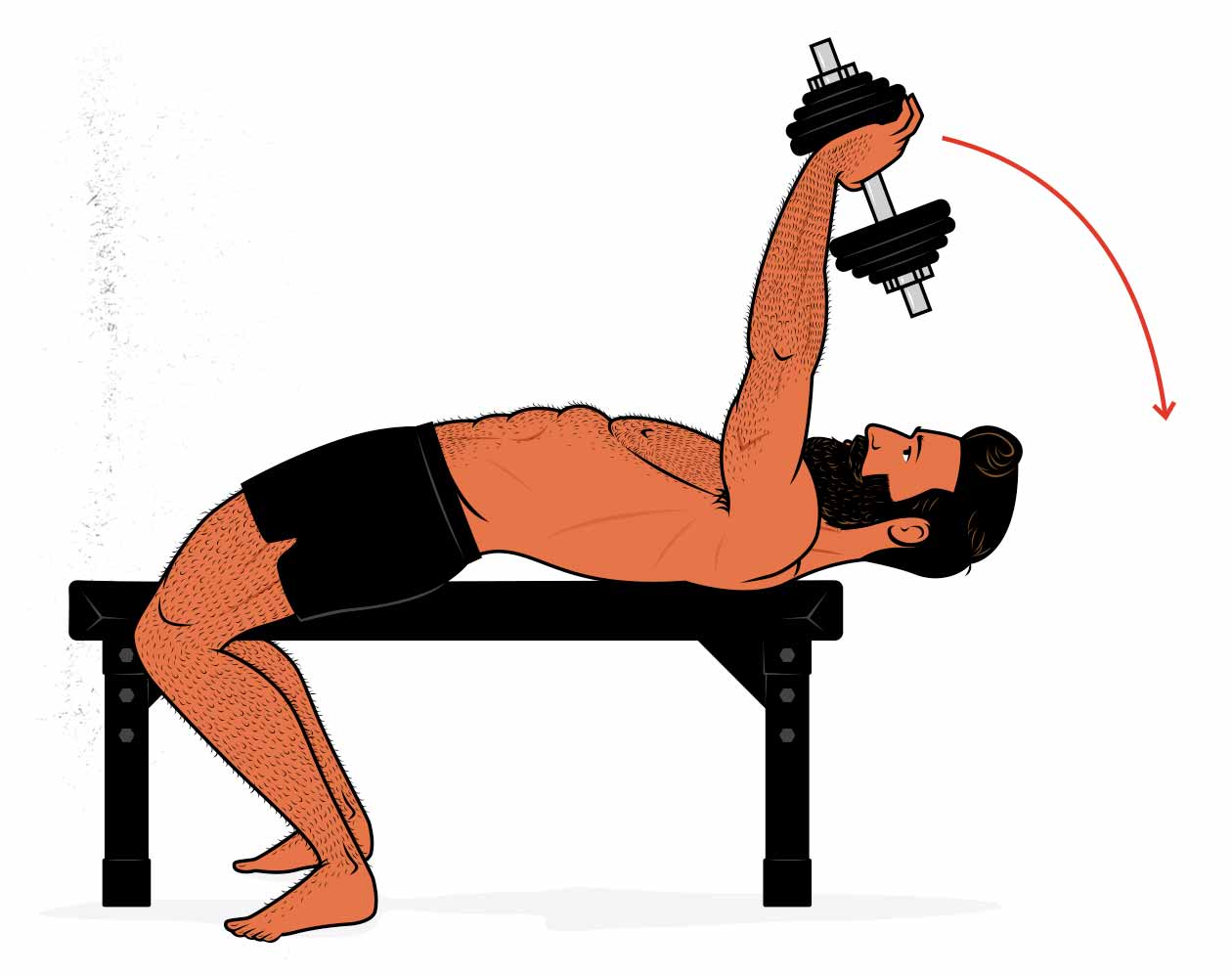
As with the barbell pullover, you can have your head and butt on the bench or in the air—whatever is more comfortable. The main idea is to bring your arms back as far as you can, giving your upper back muscles a good stretch. Feel free to let your elbows bend a little bit if it makes the lift feel more comfortable or if it stops your triceps from limiting your performance.
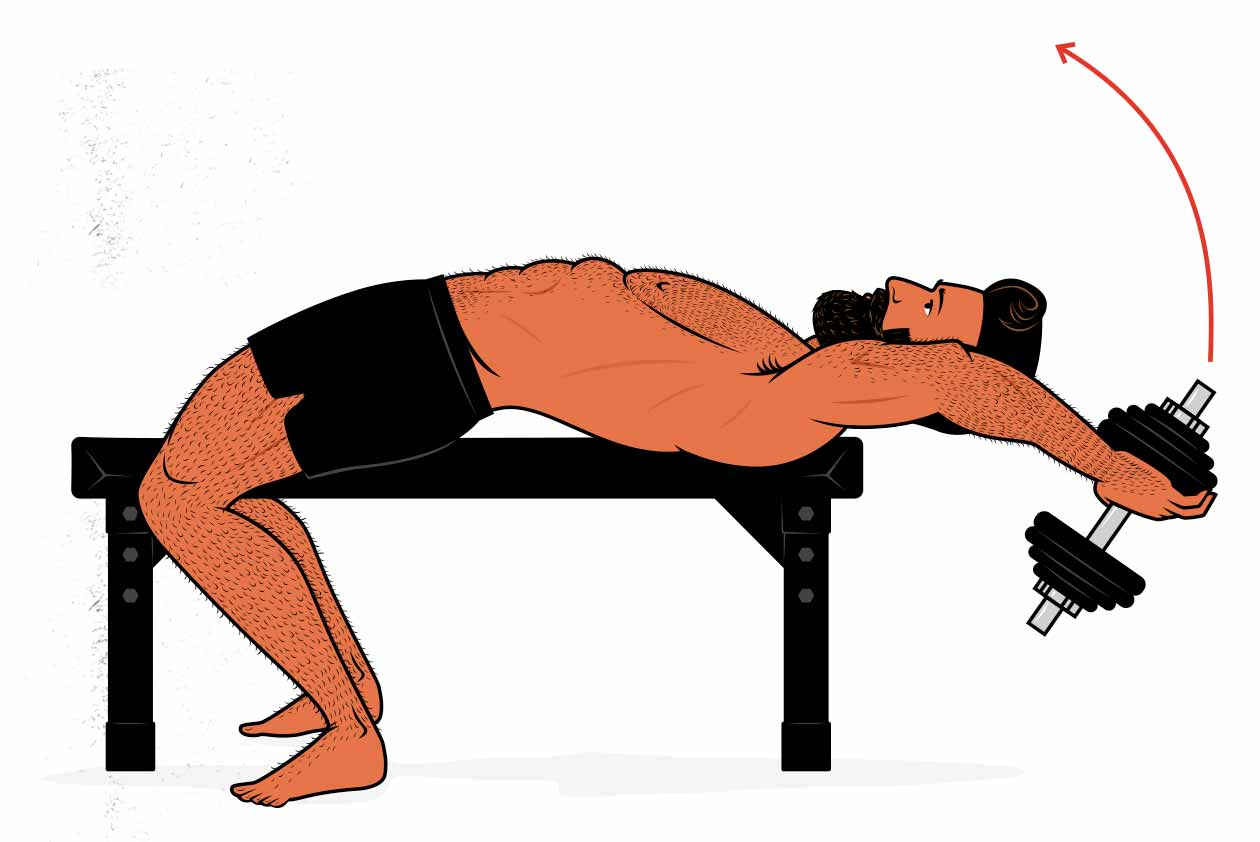
Similar to the barbell pullover, the dumbbell pullover is an amazing teres major exercise and a worthy replacement for the lat pulldown:
- You get a great stretch on your teres major at the bottom of the lift, allowing you to train them through a huge range of motion.
- The dumbbell pullover has an awesome strength curve. It’s challenging at the bottom of the range of motion, working your muscles hard where it matters most.
- Your teres major are the limiting factor. Your triceps, lats, and pecs will engage, too, but your teres major and rhomboids do most of the heavy lifting. That means you can bring them close enough to failure to stimulate an optimal amount of muscle growth.
- You can use whatever load you want, lift in any rep range, and progressively overload it. If you get too strong for a single dumbbell, you can do it one arm at a time.
- You can do dumbbell pullovers after your chin-ups and pullups, making it a great secondary exercise.
The Dumbbell Row
The dumbbell row isn’t a perfect substitute for the lat pulldown. The range of motion isn’t as big, and it doesn’t work our lats under a deep stretch. It’s a rather different lift. However, it does work our lats, and if we think of driving our elbows back, rowing low towards our stomachs, we can get a lift that emphasizes our lats.
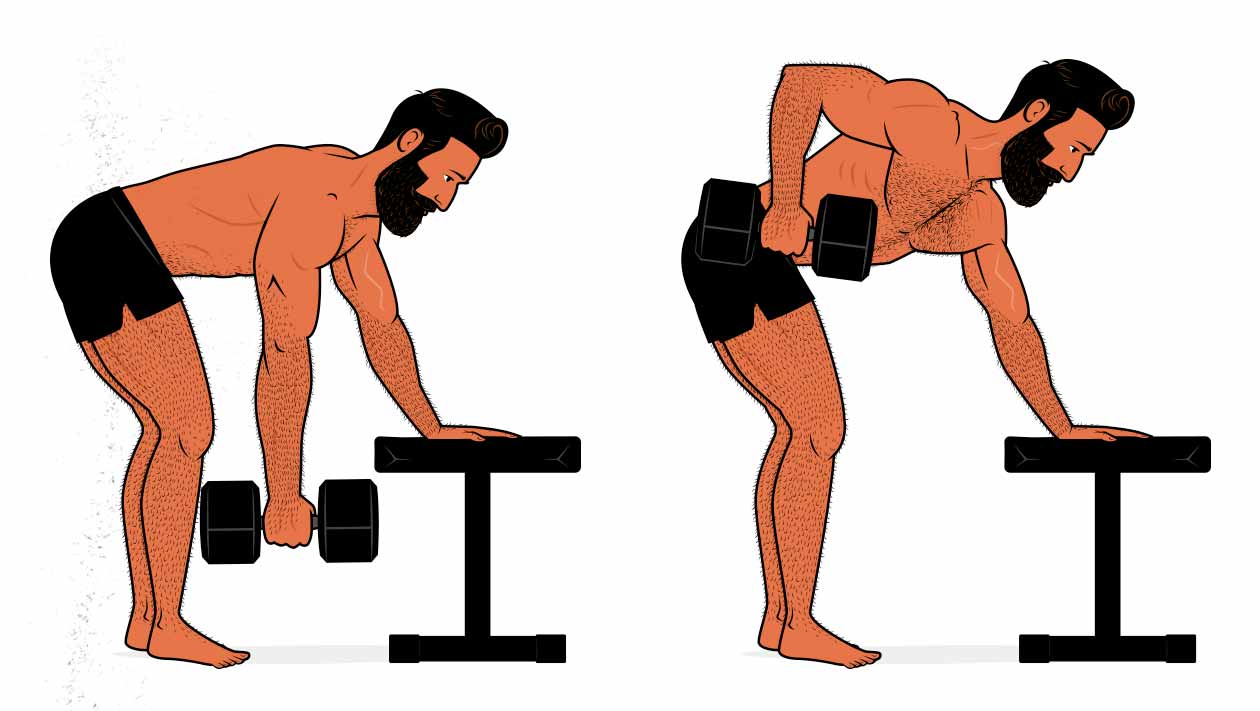
One of the big issues with replacing lat pulldowns is variety. We don’t want just to be doing chin-ups, chin-ups, pullovers, and pullovers. Better to add some other lifts into the mix. That’s where rows come in. They let us use a mix of vertical and horizontal pulling to develop more versatile strength, more balanced musculature, and a bigger upper back.
Sample Free-Weight Back Workout
When you’re training at a gym, you’ll probably be using a few different lifts to train your upper back, and some of those might be done on exercise machines, like so:
- Conventional or Romanian Deadlifts: 3 sets of 5 repetitions (3×5) for your spinal erectors and upper traps.
- (Weighted) Chin-Ups: 4×6 for your biceps and upper back.
- T-Bar Rows: 3×10 for your upper back without taxing your spinal erectors.
- Lat Pulldowns: 3×12 to make sure that you’re working your lats hard enough to bulk them up. (And again, the spinal erectors get a bit of a break.)
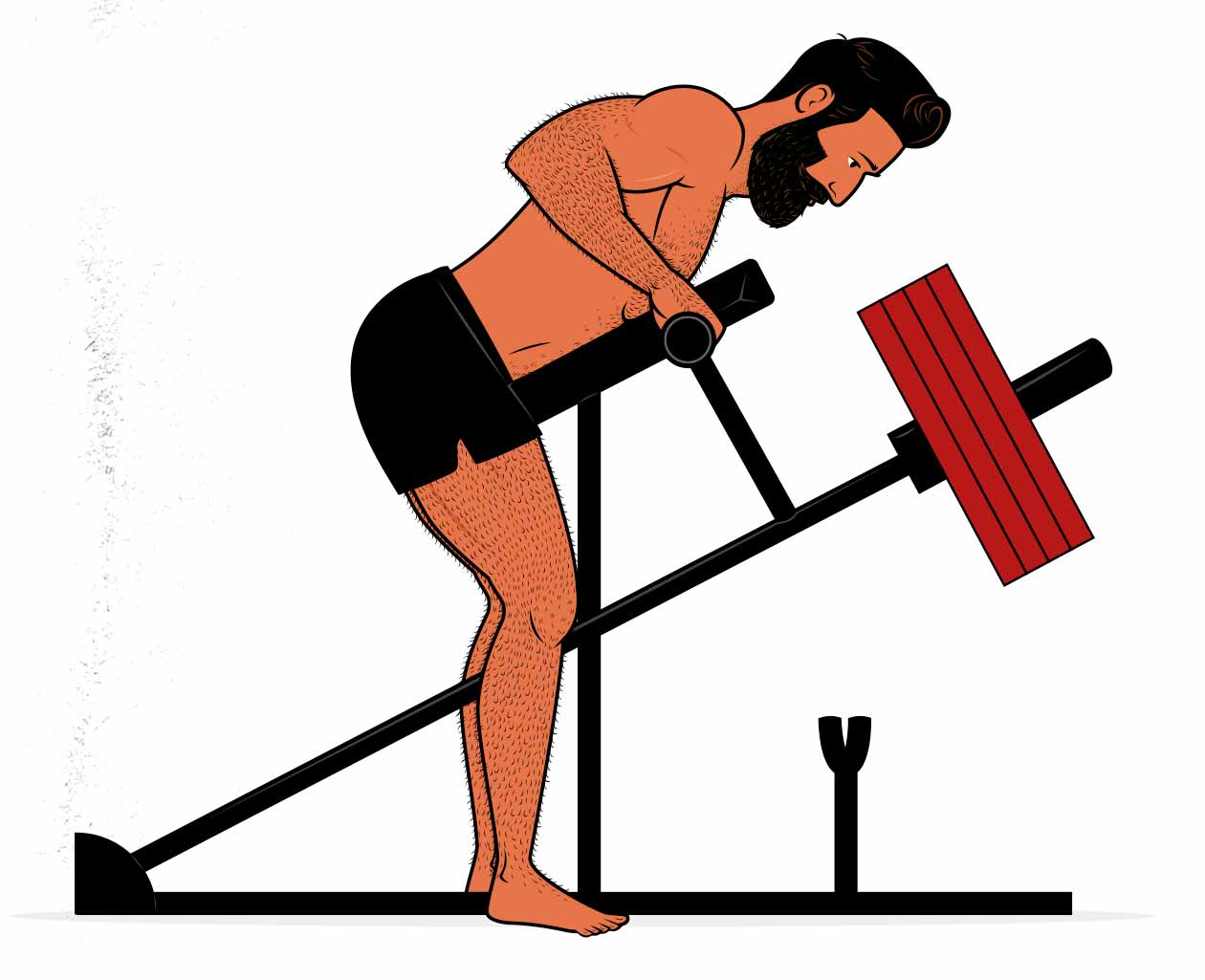
You might use different lifts, and that’s fine. That’s just an example. And these lifts aren’t necessarily done one after another on a Pull Day, they’re just done over the course of the week, maybe as part of a few different full-body workouts. Still, these are a common mix of lifts that people use to build bigger upper backs.
If we’re swapping out the exercise machines for barbell lifts, we get something like this:
- Conventional or Romanian Deadlifts: 3×5 for your spinal erectors and upper traps.
- (Weighted) Chin-Ups: 4×6 for your biceps and upper back.
- Barbell Rows: 3×15 for your upper back and spinal erectors.
- Barbell Pullovers: 3×12 to challenge your lats under a deep stretch, and to make sure they get a chance to be the limiting factor on a lift.
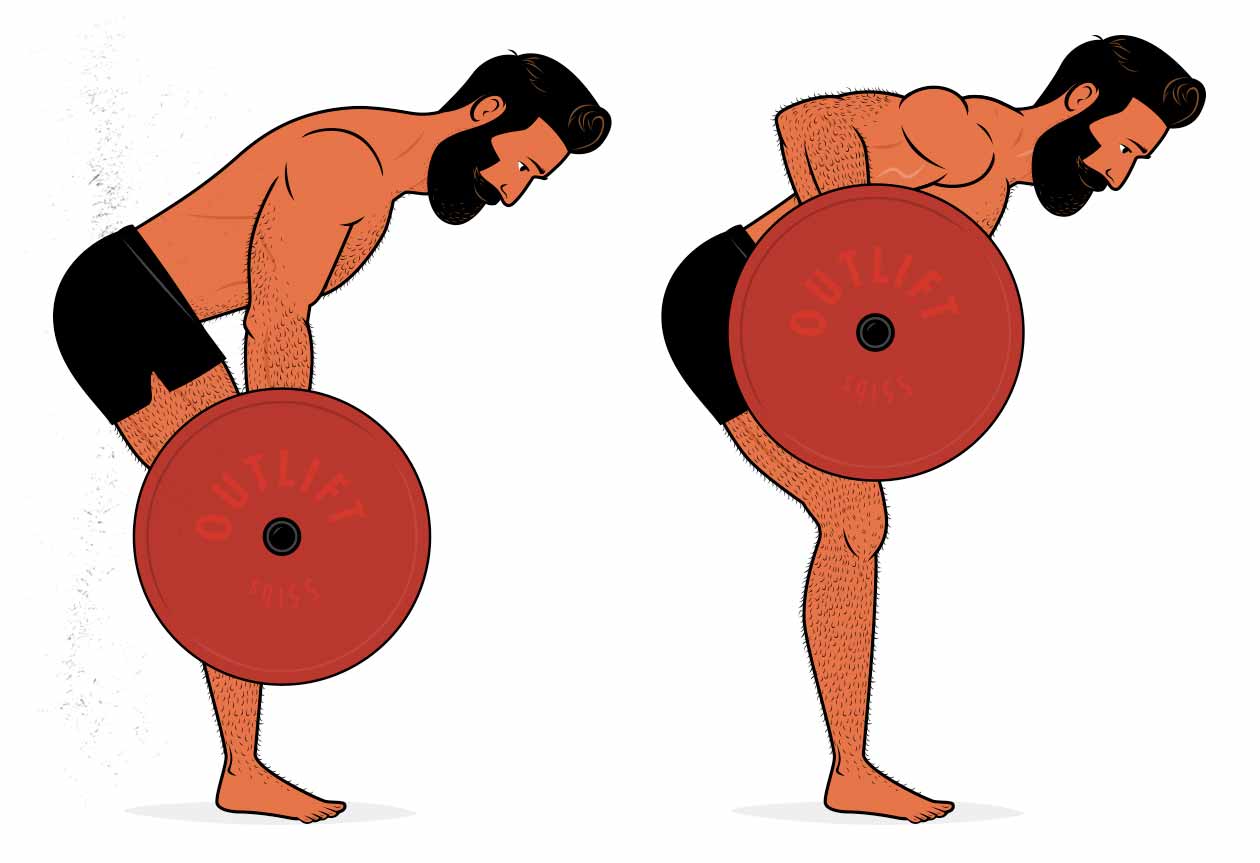
If you’re using dumbbells:
- Dumbbell Romanian Deadlifts: 3×10+ for your spinal erectors and upper traps.
- (Weighted) Chin-Ups: 4×6 for your biceps and upper back.
- Dumbbell Rows: 3×10–15 for your upper back without taxing your spinal erectors.
- Dumbbell Pullovers: 3×12 to challenge your lats under a deep stretch and to make sure they get a chance to be the limiting factor on a lift.
If you don’t have a chin-up bar, you can build your back by mixing together deadlifts, dumbbell rows, and pullovers. That’s not a lot of exercise variety, but it will still do the trick!
Summary
The lat pulldown is a good exercise for working our entire upper backs, and it even gives our biceps, triceps, and forearms a bit of stimulation. Its main purpose, though, is to help us build bigger lats. So when looking for a barbell or dumbbell alternative, we want to look for exercises that help us build bigger lats.
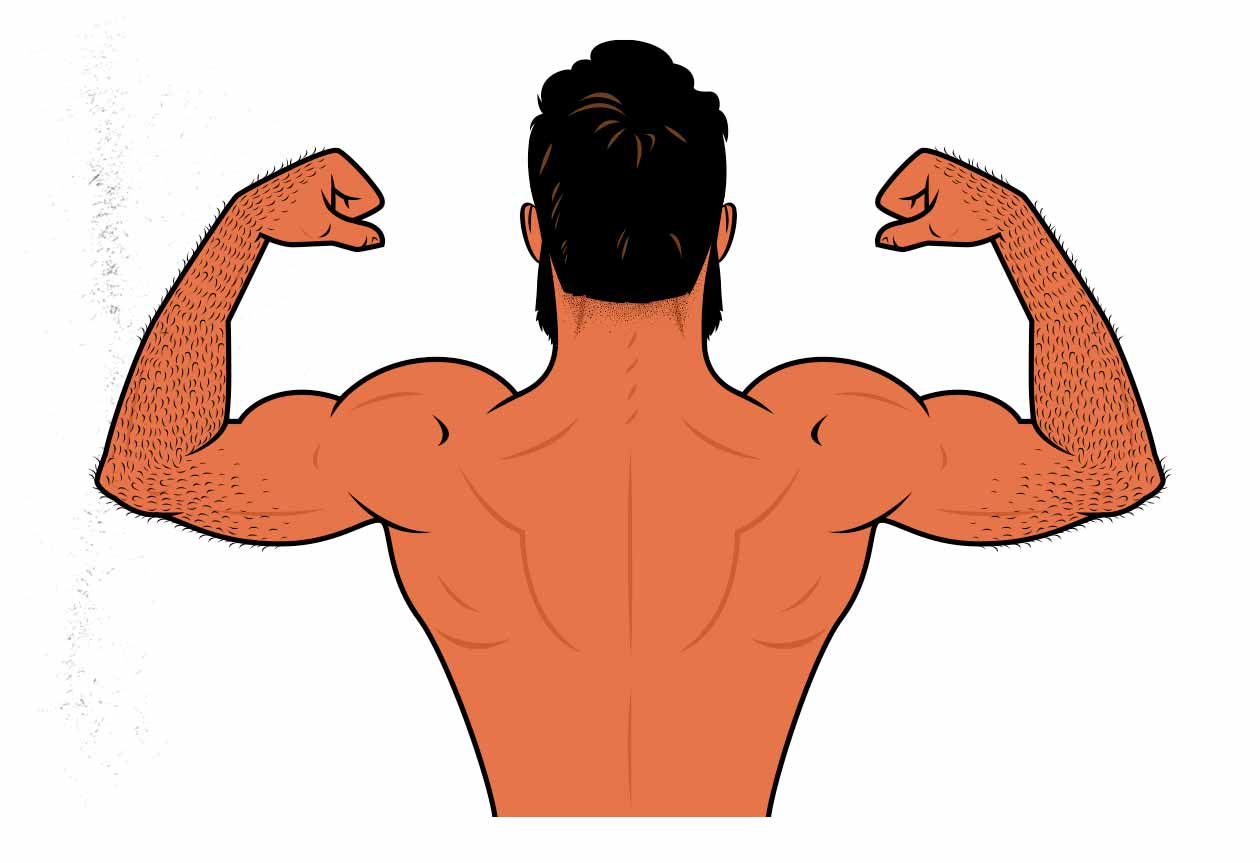
The best way to build bigger lats is to use exercises that allow us to:
- Work our lats through a large range of motion, allowing us to stimulate them fully.
- Challenge our lats in a deep stretch, allowing us to put more mechanical tension on them, speeding up muscle growth.
- Be limited by the strength of our lats so that we can guarantee that we’re working them hard enough.
That gives us a few good alternatives to the lat pulldown:
- The pull-up: this exercise works our lats in a near-identical way to the lat pulldown. The problem is, you may not be strong enough to do 6–20 pull-ups in a row, and you might already be doing them.
- The chin-up: the chin-up works our lats just as hard as the pull-up and lat pulldown, but it also engages our biceps and other upper-back muscles, making it a bigger compound lift. Because we have more muscles working, we’re often able to do more repetitions. This makes chin-ups somewhat more versatile, even if they aren’t as good at isolating the lats.
- Barbell and dumbbell rows: these aren’t a perfect replacement for chin-ups, pull-ups, and lat pulldowns, since they don’t work our lats through as large of a range of motion, but they’re still pretty good! Even with limited equipment, you can build fearsome lats with just rows.
- The pullover: these can be done with either a barbell or dumbbells. They work your teres major and rhomboids through a large range of motion and challenge them under a deep stretch. This makes pullovers a great upper back exercise that can be done at home, perhaps doing the best job of replacing the lat pulldown.
The trick is to build your workout routine around the big compound lifts, such as deadlifts and chin-ups, and then to use the lighter lifts afterwards, such as rows and pullovers. If you can do that, you can build a huge upper back without needing cables or exercise machines.

As always, if you want a customizable workout program (and full guide) that builds these principles in, check out our Outlift Intermediate Bulking Program. We also have our Bony to Beastly (men’s) program and Bony to Bombshell (women’s) program for skinny and skinny-fat beginners. If you liked this article, you’ll love our full programs.



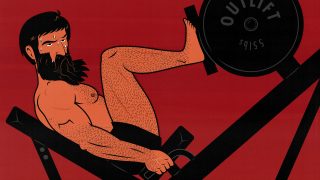
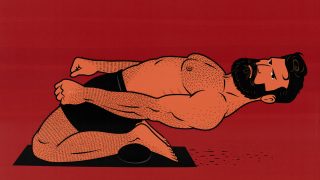

Excellent article. Looking forward to adding the pullovers to my at-home workout routine. Do you have any leg press alternatives?
Thank you, Danielle!
Yeah, squats. They work our legs in a similar way to a leg press, just with some extra back work thrown in. There are tons of variations: goblet squats, front squats, back squats, split squats, and so on.
Step-ups can work, too.
Great article. Any thoughts on combining the pullover and skullcrusher (i.e. pausing at the top of the pullover, performing a triceps extension, then finishing the pullover, or something akin to that)?
PS: I come back to this site constantly. It’s a great reservoir of information. Thanks for all your hard work!
Hey Dave, thank you!
With compound exercises, you’re getting the most stimulation in the muscle that limits you. With squats, for instance, your quads will get a great growth stimulus because they limit your performance, whereas your lower back will get less growth because it’s not brought as close to failure. With the deadlift, the opposite can happen. If your spinal erectors limit your performance, they’ll get a better growth stimulus than your hips and hamstrings.
When you take an isolation exercise and turn it into a compound exercise, you can create the problem of one muscle group being the limiting factor. For example, you know that lift where you curl the dumbbell up and then press it overhead? It’s either going to be a great biceps exercise or a great shoulder exercise. It probably won’t be both. So if you want to train both your biceps and shoulders, best to do biceps curls AND overhead presses.
Same thing with skullcrusher pullovers. If your triceps limit your performance, your lats won’t be brought as close to failure, and so they’ll get less growth. It doesn’t always happen, but it often does. I’m not sure if that would be the case here, but I worry it might be.
If it were me, I would decide which muscle you want to emphasize with the exercise and do it in the way that’s best for that muscle. Then use a different exercise for the other muscle. For instance, pullovers first, then triceps extensions.
It matters less if you’re training muscles that grow easily. When I bench, my chest always gets blasted, and my chest grows easily. If I modify the bench to be harder on my shoulders or triceps (such as with a close-grip bench press), I get more shoulder and triceps growth, but my chest still gets a great stimulus. In that case, it winds up being a net benefit. So it depends.
Maybe give it a try. Pay attention to what limits your performance, what gets a pump, and what gets sore afterwards.
Thanks for the in-depth response, I appreciate it.
Still requires weights or a bar that might be hard when traveling in an RV.
Hm. Is it possible to load an adjustable dumbbell or two into the RV?
It’s useful for me to workout at home Thanks for the article
My pleasure, man!
Hi Shane!
I got the same problem in my homegym. I am looking for an option for high rep vertical pull. I have rings and try to teach myself feet elevated ring pull ups. Is this a viable option? I love regular ups but if I do 3 sets I can only manage to get a total of maybe 20 reps of all sets. Progession from there is awkward slow.
Best Regards
Sebastian
I hear you. It can be hard to progress with just bodyweight pull-ups.
Yeah, feet-elevated pull-ups are great! You can also do inverted rows with the same setup. You could do a couple sets of those after you finish your feet-elevated pull-ups, if you want. That extra volume might help.
Thank you Shane,
Inverted rows are great. But by my understanding they are vertical pulls, do the help build a bigger Pull up or Chin up? (Bigger lats for sure). To get some volume without using to much load and producing to much fatique is always a smart thing.
You can do lower-rep pull-ups and chin-ups, you can use feet-elevated pull-ups in a higher rep range, and then you’ve also got inverted rows for even more volume if you need it. You’re right that they aren’t the same, but they still work many of the same muscles. If you want. You don’t have to do them. Just an idea.
Thanks man!